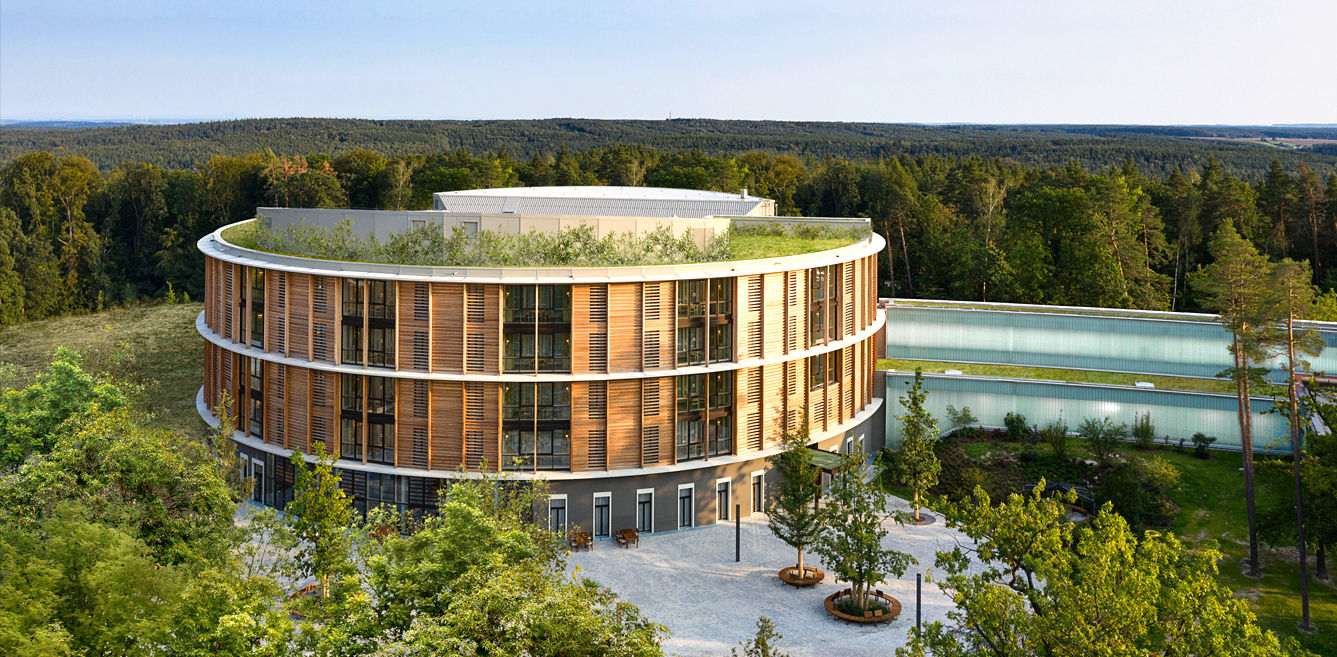

Matteo Thun
The largest orthopaedic facility in Germany, the Waldkliniken Eisenberg has a design language scripted by Italian architect Matteo Thun that combines the aesthetics of hospitality with the requirements of healthcare
Ideally located in the middle of the Thuringian Forest in the Saale-Holzland district, Waldkliniken Eisenberg is the largest Orthopedic Centre in Germany with an internationally known professorship for Orthopedics at the University of Jena. The objective behind the design of the new building was to positively influence the relationship between the physical space and human wellbeing. The architecture and interior of the new hospital building is such that it convinced the Ministry of Thuringia to declare it as the most ecological, sustainable and economical concept.
The circular building has a facade made of local wood, with 128 patient rooms and 246 beds to accommodate orthopedic patients post their operations in a space that consciously puts its temporary residents at the centre. The architecture for the hospital corresponds to the concept of ‘Hospitecture’—a design language that combines the aesthetics of hospitality projects with the requirements of the healthcare sector. The focus is the guest (latin: hospes), and architect Matteo Thun believes, “the patient is the guest.” The architecture and interior of the hospital are thus intended to cater to the guests and promote their healing.
Living Amidst Nature
Surrounded by a forest and with 55 newly planted trees in the direct outdoor area, the wooden circular structure of the building puts the material wood at the centre. The design focuses on lots of green for the interior and exterior, natural materials, an interplay of inside and outside, a well-considered use of artificial and natural light, and colour compositions of flora and fauna. The interior concept offers patients the opportunity to withdraw and enjoy their privacy in the Z-shaped two-bed rooms. Spacious verandas connect the rooms, all of which face the surrounding nature. The rooms and boarding areas have a unit care concept, wherein the interior design ensures transparency not only to the nature outside, but also to the staff inside.
Healthy Food Choices
Four different culinary spaces take on four different tasks. The lobby bar welcomes guests and visitors with snacks and drinks. With a view of the green inner courtyard, the daylight-flooded restaurant ‘La Piazza’ with 100 seats for the patients forms the focal point of the building. Employees come to the ‘Bistro’ for a culinary break in a recreational atmosphere, while a fine-dining space serves the private patient area, but can be reserved by other guests as well. The kitchen offers fresh and healthy choices made with local produce and kosher food options.
Efficiency, Functionality and User-friendliness
Hospital expert HDR GmbH supported the architecture firm in planning and implementing the efficiency, functionality and user-friendliness of the new building. In order to outline the facilities according to the needs of an orthopedic patient, and to optimally design the personnel routes and rooms, the architects charted out the plans in close dialogue with the medical professionals and the nursing staff at Waldkliniken. To build the brand image, they also elaborated the CI and CI-Design for the hospital conveying the approach of architecture and interior.
A 3 Zeros project
The new building was planned according to the 3 Zeros concept: Zero Kilometres—immediate proximity to building materials and use of local skills; Zero CO2—energy management and lower emissions; and Zero Waste—life cycle management in the construction process and reuse of construction materials.
Photo credit: Gionata Xerra
Factfile
Project: Waldkliniken Eisenberg, Germany
Architects: Matteo Thun & Partners, Italy
CI design: Matteo Thun & Partners
Area: 16,500 sq m; 66,500 cubic m of converted space
Year of completion: 2020
The art world is having a moment. From the packed gallery weekends in Mumbai to…
“Hair is everything. We wish it wasn’t, so we could actually think about something else…
For most people, Coachella is about the music. Or the outfits. Or seeing someone faint…
In the middle of Mumbai's bustling cityscape, Sakura Home emerges as a contrast to chaos.…
“The 24-foot wall of Tree of Life Chintz artwork in the double-height living area is…
Homes are increasingly becoming reflections of the people who inhabit them. Conceptualised and designed by…